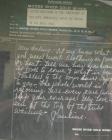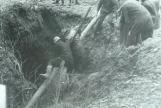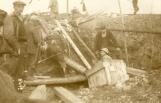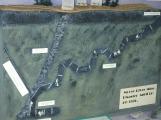1
Six days had passed and they were almost ready to give up when draegerman Billy Bell finally made contact with the men underground. They knew now that McGill was dead but frantic efforts intensified to rescue the other men.2
The pipe through which communication was made and the food was lowered.April, 1936
Moose River, Nova Scotia

3
A shaft house had to be torn down to provide material for the new shaft that was being built.April, 1936
Moose River, Nova Scotia

4
Efforts were intensified and it was now clear it was as dangerous for the workers as the trapped men. They abandoned their work in the Meagher shaft, then the Marr. The next possibility was the Reynolds shaft which until then had been considered too dangerous.Entering the shaft they found large boulders which they dug around rather than try to move. They cleared the tunnel at the rate of 4 feet per hour-passing buckets of mud and rock. The average height of the tunnel was 24 inches with a width of 18 to 24 inches; the men worked frantically with every inch of the tunnel needing to be timbered.
Meanwhile soup was poured carefully down the hose to the men below. Magill, who had been unconscious, sat up and asked for a drink of water. Barely had he started to drink when he fell back dead. The other two men, using most of their available strength carried the body over to the north cut of the tunnel and laid him on a board.
Scadding called the bad news up the pipe to Charlie Ivy. At the time, McGill's wife was finally sleeping and the men considered it a kindness not to wake her.
Telephone lines had been successfully connected to the main office in Middle Musquodoboit so that long distance calls could be made. The exchange usually handled 30 calls per day; on one day during the rescue a record 330 calls was made. Knowing that phone lines were available Frank Willis once again made a plea to the CRBC to allow him to go to the community.
By 9 a.m. the telephone was finally lowered successfully to the two men and Robertson talked briefly with his wife. Rescuers assured them that the rescue would be within five to ten hours.
Midmorning Frank Willis finally got permission to head to the site.
A second larger drill hole was punched through and men on the surface prepared to send down clothing and heating pads. This operation was headed by Michael Dwyer, Nova Scotia's Minister of Mines. Mr. Dwyer had been ill in bed and arrived just that morning to work several hours with the rescuers before succumbing to his fever again and being taken to the field hospital. He told reporters that the bravery of the draegermen was equal to anything he had seen during battles in the war.
More equipment including a radio receiver was lowered into the mine but by this time the men were too weak and the water level was rising too quickly for them to leave the area they were in.
Communications were almost severed when one of the men on the surface cut one of the wires by accident. After that Boyd Prest from nearby Mooseland took over the job of talking to the men; he was to stay at his post as long as it was required.
On the surface arguments broke out between the newspaper men who had persevered all week, in the rain and freezing cold, and Frank Willis who arrived and immediately got a patch from his equipment to the telephone line.
However, at 6p.m. Frank Willis broadcast to all 58 stations in Canada and 650 stations in the United States. He made world history with this first live broadcast and continued to report each half hour until midnight to millions of people who stayed up just to hear the bulletins. It got to a point where stores felt they were loosing business because people were staying home to listen for news. Advertisements went out saying that radios were available on store counters where people could pause in their shopping to listen to the newscasts.
Robertson, worried about both his and Scadding's medical condition began to question Charles Ivy about the timing of their rescue. Ivy kept reassuring them it was a matter of hours.
By 2 a.m. the next morning Scadding reported that they couldn't last much longer. The water level was rising steadily. The leader of the rescue team asked for six unmarried volunteers. Both Scadding and Robertson asked if blasting would help; alternately wanting and not wanting to risk being killed by the very blast that might save them.
It started to rain and tar paper shelters had to be hastily constructed over the open pit. Six men deep in the shaft were making a final desperate attempt at rescue; using two gallon buckets they passed out rubble from the shaft in a chain to twenty men waiting closer to the surface.
By mid afternoon the rescue crew reached the original sloping shaft of the Magill mine. This meant that the work slowed even more as timbers and soil had to be carefully moved.
Early Wednesday morning Frank Willis got word that a newspaper had reported that the mine had collapsed and the miners were killed. He instantly broadcast that no such thing had happened. His language was so strong that the CRBC temporarily cut his broadcasts and ordered him to calm down and rest.
A need for more timber for shoring had the men on the surface tearing down buildings to be used for timber.
By noon one newspaper reported a rescue. In reality a few feet of fallen debris separated the rescue crews from the men. Frank Willis continued to report to the world what was taking place; by this time he hadn't had food or sleep since he had arrived four days before.
At 11:40 p.m. those on the surface heard the long awaited words: "They've arrived here; everything is hunky-dory" The three man crew who had broken through removed their shirts and wrapped them around Robertson and Scadding. Dr. Davis, the provincial Minister of Health crawled down the tunnel and examined the men before they attempted to help them to the surface.
Slowly and carefully Dr. Roberston started to crawl to the surface, getting most of the way unassisted. At 12:44 on Thursday, April 23, 1936 Dr. Robertson arrived on the surface.
Ironically history was not recorded by photo or newscast the very second of his arrival-camera batteries failed and human error was blamed for a technician not being on hand to assist Frank Willis. Draegermen danced in victory and the Salvation Army men broke into the song "Praise God From Whom All Blessings Flow".
Mrs. Robertson hugged her husband briefly and he was whisked away to the field hospital.
Meanwhile James Rushton carried Scadding most of the way to the surface; they arrived at 1 a.m. and he was immediately rushed to the hospital.
Rushton and Duncan McNeil of Springhill went back into the mine and carefully removed McGill's body.
In the last several hours the roof of the rescue tunnel had dropped 6 inches. At 2 a.m. the last live transmission was made from the site by Frank Willis. By dawn the area was almost deserted. Later first Scadding and then Robertson were air lifted to hospital in Halifax.
5
A photo of the letter that Mrs. Robertson dropped down the pipe to her husband while he was trapped.April, 1936
Moose River, Nova Scotia

6
A close up of Boyd Prest talking to the trapped miners; this famous photo was made into a post card.April, 1936
Moose River, Nova Scotia

10
Robertson was airlifted to the ship yards in Halifax after being rescued from the mine cave in.April, 1936
Halifax, Nova Scotia




